Resources
Health Literacy Innovations is proud to offer a library that includes the latest research and news on health literacy. Use the menu on the left to browse our collection.
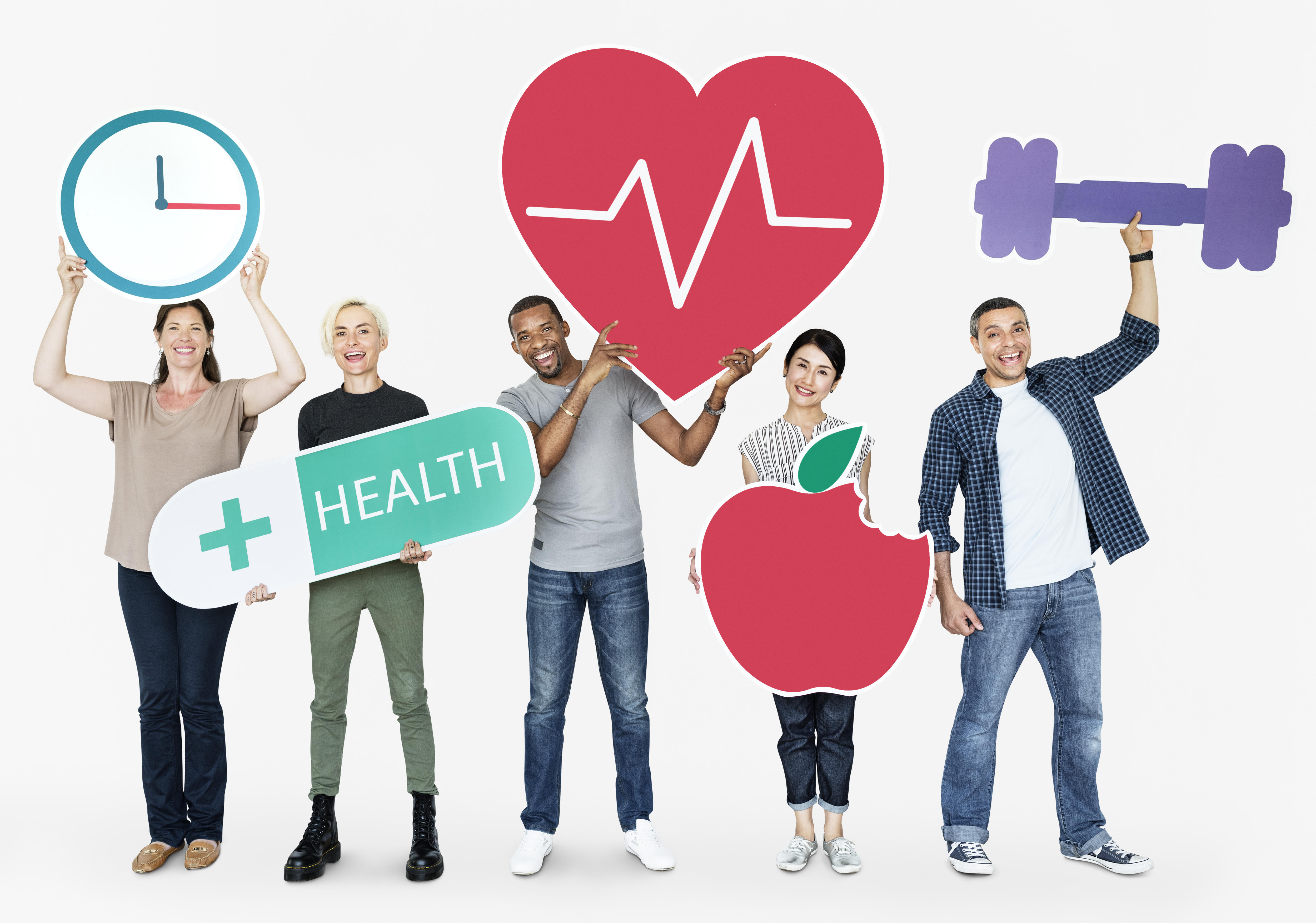
This Fact Sheet is used with the permission of the Center for Health Care Strategies, Inc. All CHCS Health Literacy Fact Sheets are available in pdf form at www.chcs.org.
Patients with poor health literacy skills struggle to understand basic medical forms and instructions.
“… [W]hen they give you papers to fill out … you want to know what it means before you sign it … [but it’s] sign this, sign that. I don’t know what that means.”
– A Patient 1
- It is especially difficult for less literate patients to fill out intake forms, enroll in insurance programs for which they may be eligible, get services once enrolled, follow medical instructions, or give informed consent.
- Most informed consent and insurance forms, and most medication package inserts, are written at high school level or higher. 2 3
- Of 979 emergency department patients with inadequate health literacy: 4
- 81% could not read the rights and responsibilities section of a Medicaid application.
- 74% did not know if they were eligible for free care.
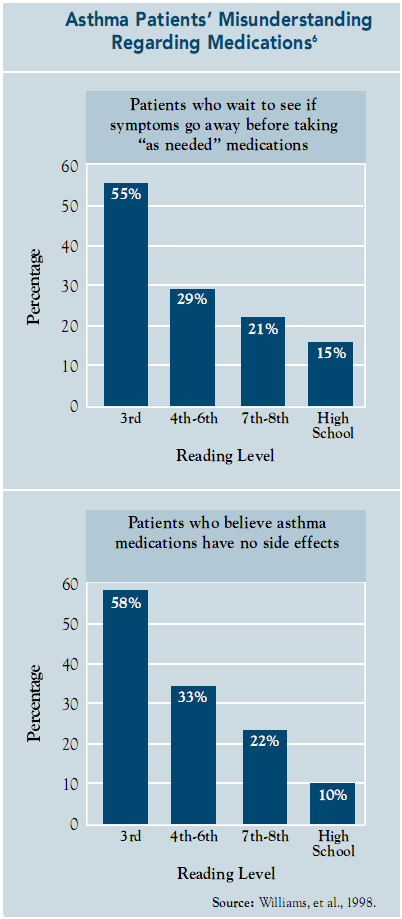
Prescription labels and self-care instructions are among the most important written materials patients receive.
Poor compliance with medication and care regimens can be dangerous. Yet serious mistakes may occur because the patient cannot read the instructions.
- Among 659 public hospital patients, those with poor health literacy skills were five times more likely to misinterpret their prescriptions than those with adequate skills. 5
- Reading skill was the strongest predictor of asthma knowledge in a study of 483 patients. Only 11% of those reading below a third-grade reading level could use their metered dose inhaler correctly. 6
- HIV-positive adults with low functional health literacy missed more treatment doses than patients with high health literacy because they were confused by the instructions in a study of 182 patients.7
Poor health literacy has legal ramifications for health care professionals.
It is up to the health care system to be sure patients understand the information they receive well enough to apply it.
- The Food and Drug Administration, Joint Commission on Accreditation of Healthcare Organizations and the National Committee for Quality Assurance all require that health care institutions be able to document evidence of patient understanding of the medical information provided to them. 8 9 10 11
- But none of these can document whether a particular patient understands the one form they need at the moment. This leaves it up to the person requesting the data, the provider conducting the procedure or writing the prescription, or the practitioner providing the instructions to ask the patient what s/he under stands.
References
- Parikh NS, et al. “Shame and Health Literacy: The Unspoken Connection.” Patient Education and Counseling, 1996; 27. ↑
- Hopper KD, et al. “The Readability of Currently Used Surgical/Procedure Consent Forms in the United States.” Surgery, 1998; 123. ↑
- Williams-Deane M and Potter LS. “Current Oral Contraceptive Use Instructions: An Analysis of Patient Package Inserts.” Family Planning Perspectives, 1992; 24. ↑
- Baker DW, et al. “The Relationship of Patient Reading Ability to Self-Reported Health and Use of Health Services.” American Journal of Public Health, 1997; 87. ↑
- Williams MV, et al. “Inadequate Functional Health Literacy among Patients at Two Public Hospitals.” Journal of the American Medical Association, 1995; 274.↑
- Williams MV, et al. “Inadequate Literacy is a Barrier to Asthma Knowledge and Self-Care.” Chest, 1998; 114. ↑
- Kalichman SC, et al. “Health Literacy and Health-Related Knowledge among Persons Living with HIV/AIDS.” American Journal of Preventive Medicine, 2000; 18. ↑
- Brandes W, Furnas S, and McClellan F. Literacy, Health, and the Law: An Exploration of the Law and the Plight of Marginal Readers within the Health Care System: Advocating for Patients and Providers. Health Promotion Council of Southeastern Pennsylvania, Inc., 1996. ↑
- Farley D. Label Literacy for OTC Drugs. U.S. Food and Drug Administration, 1997. ↑
- “Patient and Family Education.” Accreditation Manual for Hospitals. Joint Commission on Accreditation of Healthcare Organizations, 1996. ↑
- Review Guidelines for the Accreditation of Managed Care Organizations. National Committee for Quality Assurance, 1995. ↑
This Fact Sheet is used with the permission of the Center for Health Care Strategies, Inc. All CHCS Health Literacy Fact Sheets are available in pdf form at www.chcs.org.
Poor health literacy can have profound financial consequences. In 2001, low functional literacy resulted in an estimated $32 to $58 billion in additional health care costs.
According to the National Adult Literacy Survey (NALS), as many as 44 million people (age 16 and older), or 23% of all adults in the United States are functionally illiterate. An additional 28% of all adults — 53.5 million people — had only marginally better reading and computational skills. This suggests that nearly 50% of all adults may have problems understanding prescriptions, appointment slips, informed consent documents, insurance forms, and health education materials. 1
After adjusting for health status, education level, socio-economic status, and other demographic factors, people with low functional literacy have less ability to care for chronic conditions and use more health care services. In 1998, for example:
- Adults whose functional literacy was in the bottom 20% were more than 1.5 times more likely to visit a physician than adults with higher functional literacy. 2
- Adults whose functional literacy was in the bottom 20% were likely to have 3 times as many prescriptions filled than adults with higher functional literacy. 3
This finding was recently confirmed by modeling the probability of low functional literacy skills using data from NALS and applying those probabilities to people in the 1998 Medical Expenditure Panel Survey (MEPS). 4 A model was estimated, using information that was similar in both NALS and MEPS that would predict the observed literacy scores in the NALS. This model included age, educational attainment, race, gender, marital status, and employment status. The study found that people whose estimated level of functional literacy was in the lowest 20% used substantially more health care services, resulting in greater health care expenditures. The study controlled for age, gender, health status, income, and type of insurance coverage.
The following tables show average expenditures per person by health status and family income among people whose estimated functional literacy is in the bottom 20% compared to the rest of the population. Average per person expenditures were greater among those most likely to have low functional literacy.

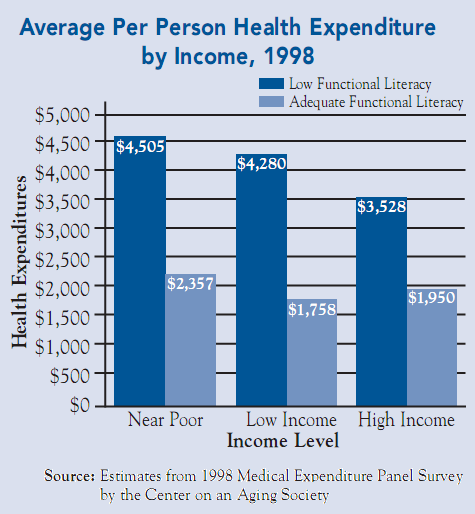
The direct medical costs of low functional literacy are financed through additional hospital and office visits, longer hospital stays, extra tests, procedures, and prescriptions. While all payers fund these additional resources, taxpayers finance a disproportionate share:
- Medicaid finances 47% of the additional health care expenditures.
- Medicare finances 19% of the expenditures.
- Employers may be financing as much as 14% of the additional health care expenditures for their employees and their employees’ dependents.
- The patients who have the poorest health literacy skills finance 14% of these additional health care expenditures as out-of-pocket co-payments and deductibles.

References
- Kirsch I.S., et al. Adult Literacy in America: A First Look at the Results of the National Adult Literacy Survey. National Center for Education Statistics, Department of Education, 1993. ↑
- Center on an Aging Society tabulations from the Medical Expenditure Panel Survey, 1998. ↑
- Center on an Aging Society tabulations from the Medical Expenditure Panel Survey, 1998. ↑
- Funding for this research was provided by Pfizer Inc to the Center on an Aging Society. ↑
This Fact Sheet is used with the permission of the Center for Health Care Strategies, Inc. All CHCS Health Literacy Fact Sheets are available in pdf form at www.chcs.org.
Health literacy problems affect people from all backgrounds, especially those with chronic health problems.
Older people, non-whites, immigrants, and those with low incomes are disproportionately more likely to have trouble reading and understanding health-related information.
- According to the National Adult Literacy Survey (NALS): 1
- 66% of U.S. adults age 60 and over have inadequate or marginal literacy skills.
- 50% of welfare recipients read below fifthgrade level.
- 50% of Hispanic Americans and 40% of African Americans have reading problems.
- Inadequate literacy was an independent risk factor for hospital admission among 3,260 elderly managed care enrollees. 2
- Health literacy problems were independently associated with worse glycemic control among 408 English- and Spanish-speaking patients with diabetes. 3
Those with poor health literacy are more likely to have a chronic disease and less likely to get the health care they need.
- According to the NALS1, 75% of Americans who reported having a long-term illness (six months or more) had limited literacy. This may mean they know less about their conditions or how to handle symptoms.
- Emergency room patients with inadequate literacy are twice as likely to be hospitalized as those with adequate literacy — even after adjusting for self-reported health, health insurance, and socioeconomic characteristics (32% vs. 15% in a study of 979 patients). 4

But “You can’t tell by looking.”
Even practitioners who have worked with low-literacy patients for years are often surprised at the poor reading skills of some of their most poised and articulate patients. 6
- Two-thirds of 58 patients who admitted having reading difficulties had never told their spouse. Nine of them had told no one. 7
- Physicians at a women’s health clinic could identify only 20% of their patients who were at the lowest literacy level (third grade). 8

References
- Kirsch J, et al. Adult Literacy in America: A First Look at the Results of the National Adult Literacy Survey (NALS). Department of Education, 1993. ↑
- Baker DW. “Functional Health Literacy and the Risk of Hospital Admission among Medicare Managed Care Enrollees.” American Journal of Public Health, 2002; 92. ↑
- Schillinger D, et al. “Association of Health Literacy with Diabetes Outcomes.” Journal of the American Medical Association, 2002; 288. ↑
- Baker DW, et al. “Health Literacy and the Risk of Hospital Admission.” Journal of General Internal Medicine, 1998; 13. ↑
- Williams MV, et al. “Relationship of Functional Health Literacy to Patients’ Knowledge of their Chronic Disease: A Study of Patients with Hypertension and Diabetes.” Archives of Internal Medicine, 1998; 158. ↑
- Parker R, Williams MV, and Davis T. Low Health Literacy — You Can’t Tell by Looking. American Medical Association Foundation, 1999. ↑
- Parikh NS, et al. “Shame and Health Literacy: The Unspoken Connection.” Patient Education and Counseling, 1996; 27. ↑
- Lindau ST, et al. “The Association of Health Literacy with Cervical Cancer Prevention Knowledge and Health Behaviors in a Multiethnic Cohort of Women.” American Journal of Obstetrics and Gynecology, 2002; 186. ↑
This Fact Sheet is used with the permission of the Center for Health Care Strategies, Inc. All CHCS Health Literacy Fact Sheets are available in pdf form at www.chcs.org.
Health literacy is the ability to read, understand
and act on health care information.
Healthy People 2010 defines health literacy as “the degree to which individuals have the capacity to obtain, process, and understand basic health information and services needed to make appropriate health decisions.” 1
The AMA Council of Scientific Affairs more specifically defines functional health literacy as “the ability to read and comprehend prescription bottles, appointment slips, and the other essential health related materials required to successfully function as a patient.” 2
- A study of 483 asthma patients found that although two-thirds reported graduating from high school, only 60% could read above the sixth-grade level. Reading ability was the single strongest predictor of asthma knowledge. Twice as many patients reading below the third-grade level had poor metered-dose inhaler technique as patients reading at high-school level (89% vs. 48%). 3

People with low functional health literacy are less likely to: 5 6 7
- Understand written and oral information given by physicians, nurses, pharmacists, and insurers.
- Act upon necessary procedures and directions such as medication and appointment schedules.
- Be able to navigate the health system to obtain needed services.
People with low functional health literacy are more likely to: 8 9 10
- Receive health care services through publicly financed programs, even after controlling for such factors as age, education, or socioeconomic status.
- Incur higher health care costs. A study of Medicaid patients found those reading below third-grade level had average annual health care costs four times those of the overall Medicaid population.
Several studies have indicated poor health status is disproportionately high among patients with low functional health literacy. For example:
- A study of 212 low-income men found that low literacy is a better predictor than race or age of advanced prostate cancer. 11
- A study of 182 HIV-positive adults found that those with low functional health literacy were more likely to miss treatment doses than those with high health literacy because of confusion about the instructions. 12
References
- Healthy People 2010. U.S. Department of Health and Human Services, Office of Disease Prevention and Health Promotion. ↑
- Selden C, et al., Health Literacy, January 1990 through 1999. NLM Pub. No. CBM 2000-1. 2000, National Institutes of Health, National Library of Medicine. ↑
- Williams MV, et al. “Inadequate Literacy is a Barrier to Asthma Knowledge and Self-Care.” Chest, 1998; 114(4). ↑
- Williams MV, et al. “Inadequate Functional Health Literacy Among Patients at Two Public Hospitals.” Journal of the American Medical Association, 1995; 274(21). ↑
- Hopper KD, et al. “The Readability of Currently Used Surgical/Procedure Consent Forms in the United States.” Surgery, 1998; 123(5). ↑
- Davis TC, et al. “Knowledge and Attitude on Screening Mammography among Low-Literate, Low-Income Women.” Cancer, 1996; 78(9). ↑
- Baker DW, et al. “The Health Care Experience of Patients with Low Literacy.” Archives of Family Medicine, 1996; 5(6). ↑
- Gazmararian JA, et al. “Health Literacy among Medicare Enrollees in a Managed Care Organization.” Journal of the American Medical Association, 1999; 281(6). ↑
- Weiss BD, et al. “Illiteracy among Medicaid Recipients and its Relationship to Health Care Costs.” Journal of Health Care for the Poor and Underserved, 1994; 5(2). ↑
- Address Low Literacy Issues to Improve Medicaid Risk Member Compliance, Reduce Costs. Public Sector Contract Report, 1998; 4(2) ↑
- Bennett CL, et al. “Relation between Literacy, Race, and Stage of Presentation among Low-Income Patients with Prostate Cancer.” Journal of Clinical Oncology, 1998; 16(9). ↑
- Kalichman SC, Ramachandran B, and Catz S. “Adherence to Combination Antiretroviral Therapies in HIV Patients of Low Health Literacy.” Journal of General Internal Medicine, 1999; 14(5). ↑
The "National Survey of Medicaid Guidelines for Health Literacy" reveals that many Americans have low health literacy levels, making it difficult for them to understand their health care information. Despite this, most health care materials are produced at a high reading level.
The survey focused on Medicaid guidelines and found that the majority of states have health literacy standards. However, the responsibility for compliance varies. States are encouraged to continue setting reading level requirements and support staff in promoting health literacy for better understanding of health information.
Click here to request a copy of the PDF

To help writers understand and best use readability indices to simplify information for health care consumers, Health Literacy Innovations offers its series of free newsletters.
Focus on Readability and Readability Indices
Considering the Flesch-Kincaid (F-K) Grade Level?
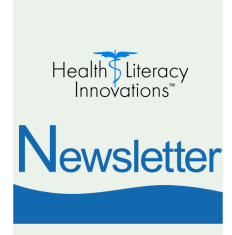
Compiled from resources from around the globe, this unique health literacy guide gives users basic, yet important information to help health communicators understand the difference between literacy, plain language, and low health literacy. It further delivers more than a dozen comprehensive sections that include plans, toolkit, guides, initiatives, training, technology, conference opportunities, and more. As an update to HLI’s previous Health Literacy & Plain Language Guide, the Second Edition includes 50 additional pages of timely resources.
Click here to request a copy of the PDF
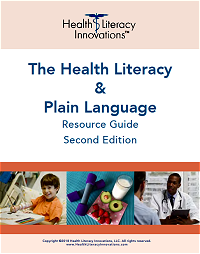
This guide was developed as part of an effort to improve the quality of the information that breast cancer screening programs provide to women. This practical guide is part of a set of activities undertaken by the International Cancer Screening Network (ICSN), a voluntary organization of members from around the world.
The ICSN works to improve the quality of cancer screening by fostering collaborative efforts aimed at understanding how to use and compare data from screening programs internationally and by developing methods to evaluate the impact of these programs.
As part of this effort, the ICSN has identified international quality measures that are being examined in many countries and used to improve program performance and outcomes.s

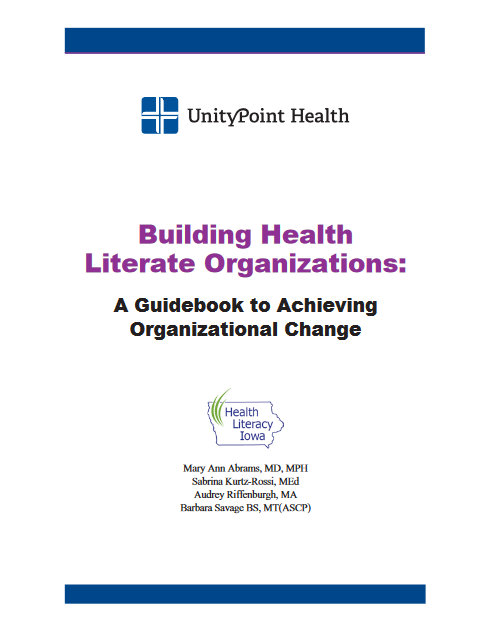
Unity Point Health
This guidebook is designed to help health care organizations of any size become more health literate. It provides resources, practical strategies, examples, and key lessons learned to support the development of a health-literate health care organization.
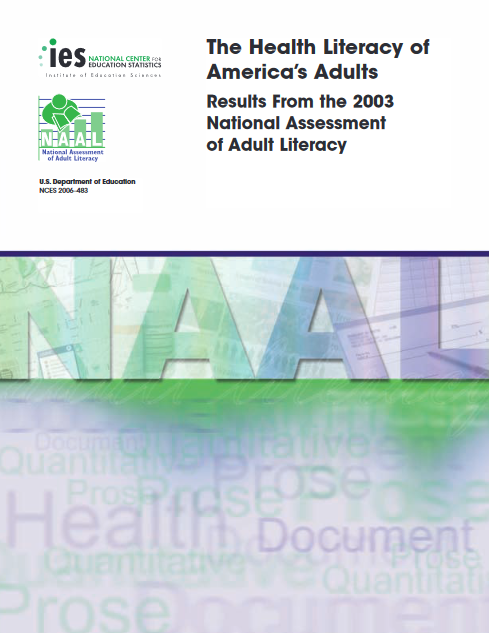
U.S. Department of Education
The 2003 National Assessment of Adult Literacy (NAAL) is a survey that measured literacy among American adults aged 16 and older, including their health literacy skills. This report provides valuable data on how adults use health information and explores connections between health literacy and factors such as education, age, race, sources of health information, and health insurance coverage.
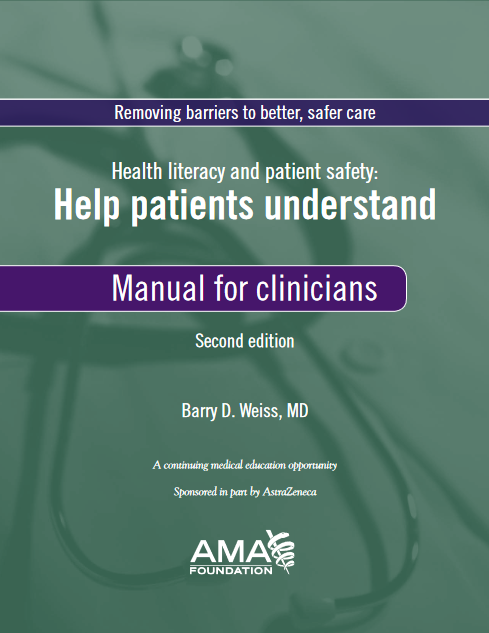
American Medical Association
This manual informs physicians, health care professionals, and patient advocates about health literacy. It enables them to understand the issue, identify barriers faced by patients with low literacy, improve communication methods, and create a supportive, shame-free environment.

U.S. Department of Health and Human Services
A plan released by the U.S. Department of Health & Human Services includes seven broad goals with multiple high-level strategies for various stakeholders, providing a focal point for the field.



